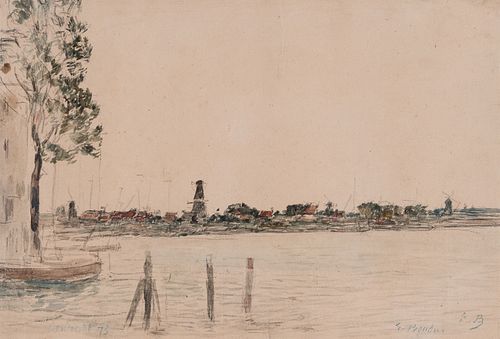EUGÈNE BOUDIN (France, 1824 - 1898). "Dordrecht, La Meuse; Study of an Estuary," 1875. Watercolor and graphite on laid paper.
Lot 122
About Seller
Setdart Auction House
Carrer Aragó 346
Barcelona
Spain
Setdart Subastas was born in 2004 and is currently the first online art auction in Spain with solidity, prestige and reliability guaranteed by our more than 60,000 users. Setdart has a young, dynamic and enterprising team ready to successfully manage the purchase and sale of art works through custom...Read more
Estimate:
EUR€9,000 - EUR€10,000
$9,375 - $10,416.67
Absentee vs Live bid
Two ways to bid:
- Leave a max absentee bid and the platform will bid on your behalf up to your maximum bid during the live auction.
- Bid live during the auction and your bids will be submitted real-time to the auctioneer.
Bid Increments
| Price | Bid Increment |
|---|---|
| EUR€0 | EUR€10 |
| EUR€200 | EUR€25 |
| EUR€500 | EUR€50 |
| EUR€1,000 | EUR€100 |
| EUR€3,000 | EUR€200 |
| EUR€5,000 | EUR€500 |
| EUR€10,000 | EUR€1,000 |
| EUR€20,000 | EUR€2,000 |
| EUR€50,000 | EUR€5,000 |
About Auction
By Setdart Auction House
Nov 10, 2021
Set Reminder
2021-11-10 08:00:00
2021-11-10 08:00:00
America/New_York
Bidsquare
Bidsquare : 19th & 20th Century paintings and Decorative Arts
https://www.bidsquare.com/auctions/setdart-auction-house/19th-20th-century-paintings-and-decorative-arts-7800
Setdart Auction House sofia@setdart.com
Setdart Auction House sofia@setdart.com
- Lot Description
EUGÈNE BOUDIN (France, 1824 - 1898). "Dordrecht, La Meuse; Study of an Estuary," 1875. Watercolor and graphite on laid paper. Attached photo certificate of authenticity issued by Manuel Schmit in 2016. Registration number in the Manuel Schmit Fine art archive: B-A.7562. The work will be included in the forthcoming Catalogue Raisonné of Eugène Boudin's works on paper. Signed, dated and located in the lower area. Provenance: Andre Seligmann, New York. Measurements: 22 x 33.5 cm; 39.5 x 50.5 cm (frame). In this work, which is conceived as a sketch, the author captures a view of the city of Dordrech, located in the Low Countries. Boudin captures in the foreground the presence of the canal and in the distance a city that stands out for the presence of windmills, a recurring theme in Impressionist painting, of which Boudin was an admired master. It is worth noting that Boudin made several visits to the city of Dordrech, in which he immortalized urban scenes and seascapes, which were always of his predilection. The 1884 visit was especially prolific, as he made numerous views of the city. The work has a photo certificate of authenticity issued by Manuel Schmit, a scholar who made a catalog raisonné of the artist. Eugène Boudin was one of the first landscape painters of the French school to paint directly in the open air, a plein air, before the Impressionists popularized this practice. He specialized in marine and harbor and coastal views, although on occasion he was also interested in green inland landscapes with animals, such as the cows grazing serenely in this beautiful panorama. He worked both in oil and pastel. His pastel sketches, synthetic and expressive, were widely praised by Baudelaire, and earned him the nickname ""king of the skies"" from Corot. The son of a dock worker, he began working on steamships as a child, always near the sea, something that would mark his work. However, in 1835 he moved with his family to Le Havre, where his father opened a frame store in which works by Constant Troyon and Jean-François Millet were exhibited. Knowledge of these painters, and also of Isabey and Couture, encouraged the young Boudin in his pictorial vocation. At the age of twenty-two he abandoned his work in commerce to devote himself fully to painting, and the following year he began a journey that would take him to Paris and Flanders. In 1850 he obtained a scholarship that allowed him to settle in the French capital, a city from which he would travel frequently to Normandy and Brittany in search of new coastal landscapes. In Boudin's work, from these early years of his career, a profound influence of the masters of Dutch Baroque landscape painting can be seen. In 1859 he made his debut at the Paris Salon, and in those years he met a very young Monet, whom he influenced to leave caricature and devote himself to landscape painting. From then on, both artists would be united by a great friendship, and in fact they would exhibit together in the first Impressionist exhibition (1874). Already fully established as an artist, in the 1870s Boudin made numerous trips, first to Belgium, the Netherlands and the south of France, and already in the 1890s he would travel regularly to Venice. He continued to exhibit his work at the Parisian Salons, and was awarded a third medal in 1881. He was also awarded a gold medal at the Paris Universal Exposition of 1889, and in 1892 he was made a knight of the French Legion of Honor. Towards the end of his life Boudin returned to the south of France, finally dying in 1898 in his native Deauville. His works are now in the Musée d'Orsay in Paris, the Hermitage in St. Petersburg, the Metropolitan in New York, the Art Institute of Chicago, the National Gallery in London, the Ashmolean Museum in Oxford, the Thyssen-Bornemisza in Madrid, etc."
- Shipping Info
-
In-house shipping available. Please inquire at admin@setdart.com.
-
- Buyer's Premium



 EUR
EUR CAD
CAD AUD
AUD GBP
GBP MXN
MXN HKD
HKD CNY
CNY MYR
MYR SEK
SEK SGD
SGD CHF
CHF THB
THB








